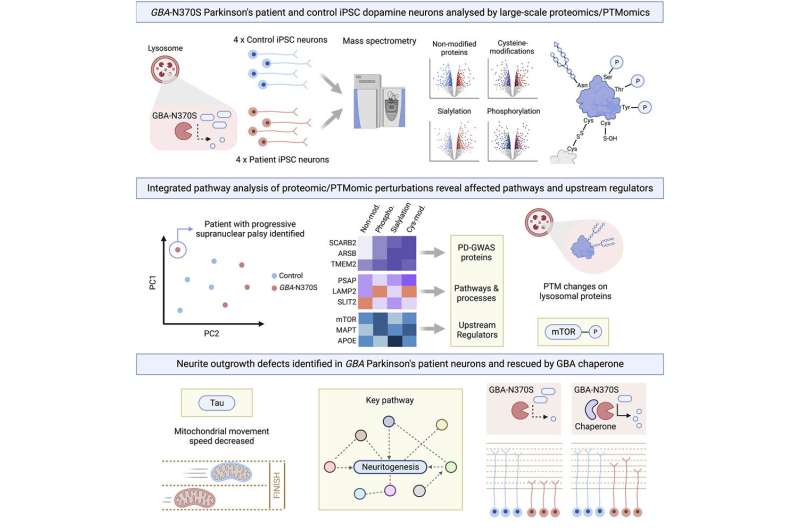This article has been reviewed according to Science X's editorial process and policies. Editors have highlighted the following attributes while ensuring the content's credibility:
fact-checked
peer-reviewed publication
proofread
New insight into dying cells in Parkinson's disease

When a patient experiences the first symptoms of Parkinson's disease, the disease has been developing for a long time, and the patient may have already lost half of a specific type of nerve cells in the brain.
Therefore, researchers are focused on understanding what happens to these brain cells before they become damaged and die.
"You want to treat this disease early," says Helle Bogetofte Barnkob, who is originally trained as a medical doctor but now researches at the Department of Biochemistry and Molecular Biology, University of Southern Denmark.
Currently, she is based at the Oxford Parkinson's Disease Center at Oxford University in England, where she studies stem cells from Parkinson's patients. Also, she is the lead author of a new scientific study published in Cell Reports. The other SDU authors are Martin Røssel Larsen, Pia Jensen, Sissel I. Schmidt, Mike B. Barnkob, and Morten Meyer, while the rest of the author team is from the Oxford Parkinson's Disease Center.
The team's scientific article provides new insight into how the dopamine-containing nerve cells that are particularly affected in Parkinson's, behave. In Parkinson's, these nerve cells die, and over time, it leads to a severe dopamine deficiency.
Dopamine is a signaling substance with two overarching functions: one is to regulate our mood and emotions, and the other is to help control our motor function and thus our mobility. Parkinson's patients experience tremors because the nerve cells with dopamine important for motor function begin to die. In addition, they also have an increased risk of depression, among other conditions.
For the study, the team developed dopamine-containing nerve cells from stem cells from Parkinson's patients and healthy individuals for control purposes. Through extensive analyses of the nerve cells' building blocks, proteins, the team found some crucial differences in their ability to form nerve extensions.
When the nerve cells are healthy, they form extensions that create connections and transfer dopamine from one nerve cell to another. The nerve cells from Parkinson's patients were found to have significantly poorer ability to form these extensions.
Helle Bogetofte Barnkob emphasizes that the team's findings were made in a laboratory and that it may not necessarily occur in a human brain: "We work with nerve cells in a petri dish, and we do not know if the same thing happens in a brain. But we can say that nerve cells developed from Parkinson's patients' stem cells cannot form extensions as well as those from healthy patients," she explains.
Since the responsible nerve cells lie deep inside our brain, researchers cannot access them or study them as the disease develops. Nerve cells made from stem cells from Parkinson's patients are therefore the closest they can currently come to looking into a Parkinson's-affected cell.
Part of the study was carried out at the Oxford Parkinson's Disease Center, where there is a large cell bank of stem cells from Parkinson's patients and healthy individuals. The second important part of the study was carried out at SDU in Odense, where advanced, proteome-analyzing equipment can provide researchers with insight into thousands of proteins and protein modifications simultaneously.
The research team also investigated whether they could do something to treat the sick nerve cells, and they found that a certain type of medication makes the cells better at forming nerve extensions. They found that the nerve cells in the petri dishes responded well to a substance used to treat the rare disease Gaucher's disease: They became better at forming nerve extensions.
The substance works by boosting the so-called GBA enzyme, which is important for the cell's maintenance work. Mutations in the GBA gene are the most common genetic risk factor for Parkinson's. The patient stem cells involved in the study all came from Parkinson's patients with a mutation in the GBA gene.
The proportion of genetically determined and therefore hereditary cases of Parkinson's is about 10 percent. This means that the vast majority—up to 90 percent of all Parkinson's cases—are sporadic and due to a mixture of environmental influences and genetic risk factors.
Helle Bogetofte Barnkob is now investigating nerve cells formed from stem cells from patients with sporadic Parkinson's. She wants to investigate, among other things, whether the same things happen in the cells of those with the mutation in the GBA gene, as in those with sporadic Parkinson's.
Parkinson's occurs in 1% of the population over 50 years of age. The incidence is highest in people over 70 years of age.
More information: Helle Bogetofte et al, Post-translational proteomics platform identifies neurite outgrowth impairments in Parkinson's disease GBA-N370S dopamine neurons, Cell Reports (2023). DOI: 10.1016/j.celrep.2023.112180



















